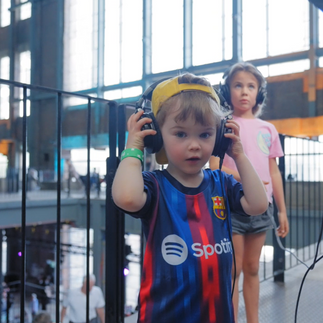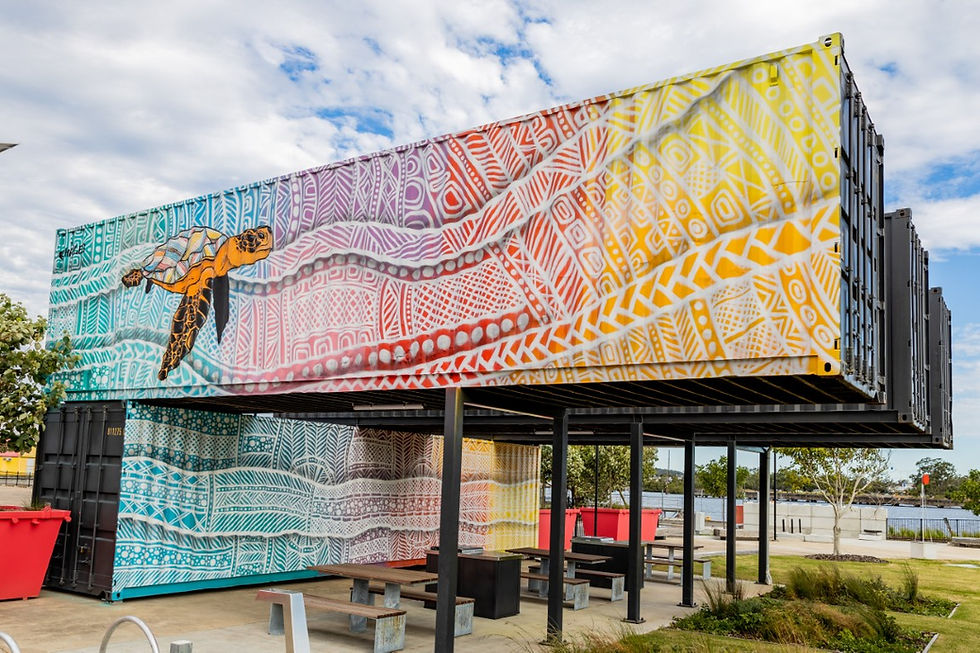From Patios to Power Stations: How Ipswich and Sydney are showcasing Place Leadership
- Place Leaders Asia Pacific

- Jun 17
- 6 min read
In placemaking, no two places share the same DNA, but across different scales, communities and contexts, there are shared principles. From hyper-local cultural revival in a growing regional city to whole-of-precinct stewardship across some of Australia’s most visited public spaces, this conversation revealed insights into the common threads that makes for great place leadership.
The May 2025 Place Leaders Asia Pacific Community of Practice brought together placemakers, planners, strategists, and urbanists from five countries to explore how place leadership operates when done well.
We heard from Erin Marchant and Courtney Strow of Ipswich City Council, recipients of the Jan Gehl Centrepiece Award for 'Excellence in Community-Led Placemaking', and Anita Mitchell, Chief Executive of Placemaking NSW, whose agency took home the Place Leadership Award for 'Leading Place Transformation of Sydney's Iconic Precincts'.
Here’s what the Place Leaders Asia Pacific Community of Practice attendees said about this session:
“Love the evidence-based, tested-with-community, insights and initiatives!”
“Wonderful to see similar principles of place flexed in a small city scale to a large multiple precinct scale.”
“Thank you! Some really great ways to revitalise the city centre starting with small steps and community building.”
“Incredibly inspirational. Thank you all for your insight and time.
Ipswich - Community-led Transformation in a Regional Centre
"Ipswich has to have the personality," said Courtney Strow, Coordinator of Creative Industries at Ipswich City Council. "It wasn’t about copying our neighbours, it was about understanding our personality - recognising our past while supporting our future.”

Ipswich's revitalisation story has unfolded since 2021. The city had endured economic downturn and natural disasters but rather than waiting for large-scale redevelopment or external rescue, Erin and Courtney led an approach based on community action and cultural confidence.
Listening First, Acting Locally
It began - as all good placemaking does! - with listening. The Council spent a year talking with businesses, artists, young people, and First Nations leaders. Pop-ups, surveys, door-knocking, and workshops all helped build a shared vision: to reimagine and reposition Ipswich Central as the city’s cultural hub and beating heart.
Video - Creators of Ipswich Summit
Small, Strategic Interventions
From this vision, a series of small, strategic interventions were implemented:
Street patios (not parklets!) were installed as social spaces, inspired by the verandas of traditional Queenslander homes.
The Green Arbour transformed underutilised public realm into shaded spaces that encouraged stop and linger behaviours.
A pop-up dog park was trialled - and then abandoned when data and community feedback showed it simply didn’t resonate. "…even though we have a really high dog population, bringing the dogs into the city centre... just didn’t line up. And we wouldn’t have known that if we didn’t have the measurement tools..." said Erin.
QR codes, ‘Shape Your Ipswich’, and real-time engagement platforms turned consultation into an ongoing two-way conversation.
Events like ‘Live and Local’, capacity-building programs like ‘ARTiculate’, and new arts hubs at Fire Station 101 and the Ipswich Art Workshop gave creatives platforms and tools.
Cultural Impact with Economic Results
Over time, these small-scale efforts added up:
Over 1,500 artists, arts workers and organisations were engaged
600+ attendees at ARTiculate capacity-building workshops
44,000+ visits to the Creators of Ipswich website
61% of all ticket sales at Council venues were from community-led events
38% of attendees at cultural venues were visiting from outside the region
But the true measure according to Erin and Courtney was that Ipswich residents were returning to their city centre because they were seeing themselves represented in its stories, programs and priorities. Culture wasn't being imposed, it was being surfaced!
"It was taking a step back and really understanding the we’re unique...," said Courtney. "It was about recognising the richness already here, and trusting our community to lead the way."
That trust has paid off: in early 2025, Ipswich secured $3.8 million in federal funding to develop a new cultural precinct, with plans to expand the Ipswich Art Gallery, redevelop the Civic Centre, and create urban greening and cycle networks.
Sydney - Whole-of-Precinct Leadership at City Scale
While Ipswich focused on the local and relational, Sydney’s iconic placemaking challenges are about scale, complexity, and stewardship. Placemaking NSW, under Anita Mitchell’s leadership, is responsible for The Rocks, Barangaroo, Darling Harbour, White Bay Power Station, and Luna Park - some of the state’s most iconic and strategically sensitive public places.
Chief Executive Anita Mitchell describes her agency’s remit as both exhilarating and exacting. These sites are heavily governed, heritage-listed, high-value assets and Anita’s team has brought renewed life, relevance, and resonance to each through what Anita described as a 'fine-grained curation' - balancing public interest, economic outcomes and heritage protection.

The Rocks: Post-COVID Renewal
Post-COVID, The Rocks historic district saw visitation plummet. Placemaking NSW responded with:
A comprehensive retail and visitation strategy, informed by spend and dwell time data
A rebalancing of tenancies, shifting away from trinkets and tourism toward artisanal retail and food and beverage
Outdoor dining lanes on George Street North, transforming car space into community space
A renewed focus on local audiences, including discounts for workers, new family-oriented events, and over 400 free activations per year
The results:
14% uplift in retail turnover since pre-COVID highs
1% vacancy rate in retail tenancies, far outperforming the Sydney CBD average
14.4 million annual visitors to The Rocks in 2024
White Bay: From Industrial Relic to Cultural Hub
At White Bay Power Station a different story was unfolding. Once earmarked for demolition, the 1917 industrial building is now Sydney’s newest cultural venue.
Placemaking NSW led a $101 million restoration, with safety, access, and sustainability at its core. The Power Station reopened in 2024 with the Biennale of Sydney, attracting over 180,000 visitors in just three months. It has since hosted Ministry of Sound, community exhibitions, and site-specific performances, all while preserving its gritty, industrial character. A digital placemaking suite, including a bespoke mobile tour app and 360-degree virtual experience allows audiences to engage with the site from anywhere.

Across the sites, this principle of thoughtful permission appeared again and again. Placemaking NSW didn't seek to dictate what people do in its spaces - it sought to enable it, safely and inclusively. For example ...
“We stopped fining people for jumping in the water... Sometimes just relaxing regulation and allowing people to do what they naturally want to do in these areas - safely, of course - is really important.”, Anita explained, reflecting on the decision to open up swimming at Marrinawi Cove.
Key Take-Away - For Place Leadership, 'Listening is the Leadership'
What unites Ipswich and Sydney is their attitude to place leadership. In both cases, the role of government was not to dictate, but to convene and enable. In Ipswich, that meant letting the community lead cultural programming, and showing up to support that leadership with grants, resources and infrastructure. In Sydney, it meant curating tenancy mixes, rethinking traffic to create public dining spaces, and seeing heritage not as a burden, but as an asset.
In different ways, and at different scales, the role of Erin, Courtney, Anita and their teams was to enable, not direct:
“We don’t say ‘we’ as Council. We say ‘we’ as Ipswich, as in community partners, businesses, and organisations.” - Courtney Strow
“That’s placemaking to me ... a constant tending and curation and a bit of a guiding hand to these wonderful precincts.” - Anita Mitchell
Both projects shared impressive numbers across economic value-add, ticket sales, and visitor increases, but the most striking similarity between Ipswich and Sydney was their humility in acknowledging the intangible outcomes: the culture shifts, the habits formed, and the partnerships.
The true measure of leadership in place? The ability to step back enough so the people who belong to a place can step forward!
Bonus - Place Leadership Beyond Borders!
This wasn’t just an Australian conversation. A French placemaking practitioner in attendance drew clear parallels with their own work in revitalising urban centres through culture and community, saying: “We're working on disseminating this type of strategy in the Greater Paris Area", and shared examples from the URBACT Cities@Heart network and the Centres-Villes Vivants program, supporting over 100 municipalities across France in their journey to reactivate city centres through place policy and cultural activation.





























Comments